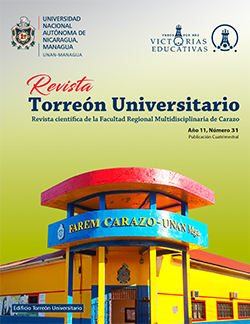Quality and potential use of the waters of the río Tipitapa
DOI:
https://doi.org/10.5377/rtu.v11i31.14292Keywords:
quality, water, Tipitapa, hydro chemistryAbstract
Nicaragua is a privileged country for its aquatic resources, however, the pristine quality of these resources is threatened by various stressors. The Tipitapa River, located in the hydrographic basin UH 69-9529, is a natural drainage conduit of the waters of Lake Xolotlán towards Lake Cocibolca, which integrates the Tisma lagoon system considered as buffer zone between the upper and lower part of the river basin. This area receives and houses xenobiotics limiting their transport to the Cocibolca. Agricultural activity is predominant in the basin and this takes advantage of the waters of the Tipitapa River for the irrigation of crops such as rice, beans, wheat, legumes, as well as for the irrigation of grassland areas, among others. This research evaluates the physicochemical quality of the waters of the Tipitapa River and its suitability for irrigation of the crops of the area. To do this, two sites before and two sites after the Tisma lagoon were sampled twice, once in the rainy season and once in the dry season. The collected water samples were physically chemically analyzed. Field parameters were measured in situ at the time of sample collection. The results of the study reveal the current water quality of the waters of the Tipitapa River, as well as their availability for agricultural activity. This research contributes with scientific information for the establishment of plans in the management of water resources.
Downloads
References
ACUMAR. (Abril de 2009). Criterios utilizados para la defnición de los valores asociados a cada zona de uso. http://www.acumar.gov.ar/ACUsentencias/ndoza/2009abril/060409e/AnexoIIusos060409.pdf
APAH. (2012). American Public Health Association (APAH). Standard Methods for the Examination or Waters and Wastewater. 22 ed. APHA.
Banco Mundial. (5 de Noviembre de 2013). Prioridades de Política e Inversión Para Reducir la Degradación Ambiental de la Cuenca del Lago de Nicaragua (Cocibolca). Los Principales Desafíos Ambientales. www.worldbank.org/lac.
Barceló, I., Allende, I., Solís, H., Bussy, A.-L., & González, C. (2002). Determinación del estado de equilibrio de un sistema hídrico. Revista de la Sociedad Química de México, 46(2), 93-104.
Castillo, F. (2018). Evaluación de la calidad ambiental del Humedal Refugio de Vida Silvestre Sistema Lagunar de Tísma, Masaya, Nicaragua. Managua: FACULTAD DE RECURSOS NATURALES Y DEL AMBIENTE (UNA).
CIRA. (2011). Evaluación del Impacto de la Calidad de Agua del lago Xolotlán sobre el río Tipitapa y el área inmediata en el lago Cocibolca (Estación lluviosa, Diciembre 2010 y Estación seca, Abril 2011. CIRA/UNAN-Managua.
CWQG/CCME. (2008). Canadian Water Quality Guidelines . Toronto: Canadian Council of Ministers of the Environment .
INAA. (1996). Normativa Ambiemtal para la clasificacion de Recursos Hidricos. : Gobierno de Nicaragua.
INETER. (2010). Identification and assessment of hydrological flows between the lakes of Managua and Nicaragua, Applying Nuclear Techniques for the Development of a Management Plan for the Watershed of the Great Lakes. Managua: Name of OIEA - Experto Hidrogeólogo, Sergio Iriarte Díaz .
INETER, & OIEA. (2011). Caracterización hidrogeológica e isótopica del acuífero Tipitapa-Malacatoya en la zona del estrecho interlagos. Proyecto OIEA & INETER.
IRENA. (1981). El agua subterránea en el área de Tipitapa-Las Banderas-San Juan-San Isidro. Instituto Nicaragüense de Recursos Naturales y del Ambiente (IRENA).
Kevern, R. (1989). Alkalinity water, classification systems. volume Part 1. Michigan: The Michigan.
MARENA. (2001). Informe del Estado Ambiental en Nicaragua. Ministerio del Ambiente y Recursos Naturales (MARENA).
Padilla, T. A., & García, N. (2012). Hidroquímica del agua superficial de la subcuenca del río Quiscab, Ciencias Técnicas Agropecuarias, 17-20.
Roldán P., G., & Ramírez R., J. J. (2008). Fundamentos de Limnología neotropical. Universidad de Antioquia.
Rueda Hernández, M. (2006). Comportamientonde las condiciones fisicoqímicas y microbiologicas de la Laguna de Tisma en el año 2000 y 2005. (UNAN-Managua, Ed.) Universidad y Ciencias, 2(3).
Zamorio A., M. J. (2018). Evaluación de la migración de contaminantes desde el Lago Xolotlán hacia el Lago Cocibolca. CIRA.
Published
How to Cite
Issue
Section
License
Copyright (c) 2022 National Autonomous University of Nicaragua, Managua (UNAN-Managua).

This work is licensed under a Creative Commons Attribution-NonCommercial-NoDerivatives 4.0 International License.
The authors who publish in this journal agree to the following terms.
- The author or authors of the articles, essays or research grant the National Autonomous University of Nicaragua, Managua (UNAN-Managua) the editing rights (copyright) of the submitted work, therefore the University has the exclusive right to publish the article for the entire copyright period.
- These copyrights/authors authorize Torreón Universitario Magazine and the University to edit and disseminate/publish the article in said Magazine, including printed and electronic reproduction, storage, retrieval and any other type of publication, and sources of secondary information as services. of summaries and databases, they also empower it to protect the article against unauthorized use for dissemination by printed or electronic media (PDF, HTML, EPUB, XML or others).
License for use of content
The magazine uses the Creative Commons Attribution-NonCommercial-NoDerivs 4.0 International License.
Under this statement:

This journal is licensed under a Creative Commons Attribution-NonCommercial-NoDerivatives 4.0 International License. It can be copied, distributed and transmitted publicly as long as the author and source are cited (Revista Torreón Universitario), it should not be modified or used for any commercial purpose. The full license can be found at http://creativecommons.org/licenses/by-nc-nd/4.0/.



